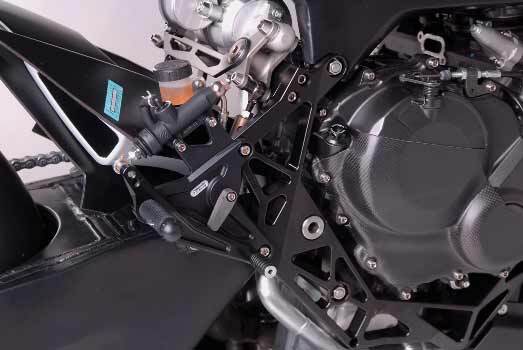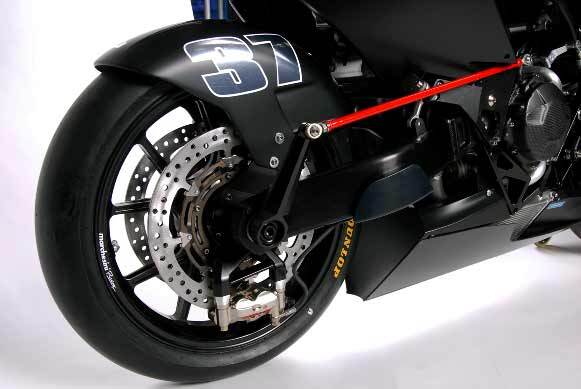Boutique Italian motorcycle company Vyrus is hoping to cause a real shake-up in top-level racing by entering its radically unorthodox Vyrus 986 M2 Factory in the heavily standardized Moto2 competition. With the same weight, engine, tires and electronics as its opponents, the Vyrus bike is more or less a controlled experiment in the racetrack effectiveness of hub-center steering. It will be the first time in decades that we've seen a machine enter top-level racing without a set of traditional telescopic forks at the front end. If it succeeds, it has a real chance at causing a suspension revolution in the sportsbike world. Oh, and there's streetbike and kit versions available too. Very exciting news.
Hub-center steering
Hub-center steering has never managed to become popular on motorcycles – presumably due to the added cost and restricted turning circle offered by such systems. Or maybe just because it looks weird, and motorcyclists can be deeply resistant to change despite their "rebellious" image.But while it may have some practical deficits around town, hub-center steering almost magically cures some of the most serious handling issues inherent in bikes with telescopic forks. There's no front-end dive under brakes, for example – so the bike's weight balance remains neutral and the suspension stays in its optimal traction management zone more of the time. You can "stay off the brakes until what seems suicidally late," as master bike tester Alan Cathcart once put it, and with the mechanical separation of steering from suspension, "there seems no limit on how hard you can push it in corners."
Cathcart made these comments after riding Vyrus's last attention-grabbing masterpiece, the 211-horsepower, 1200cc Vyrus 985 C3 4V.
Clearly, to get the best out of this sort of suspension system, you need to be hunting for tenths on a racetrack – but since Yamaha's GTS1000 of nearly 20 years ago, none of the major factories other than BMW have bothered much with anything but telescopic forks.
So it will be fascinating to see how Vyrus goes when it takes its brand new 600cc 986 M2 Factory racer out and pits it against some of the world's best racebike chassis designers on Moto2's world stage.

The Vyrus 986 M2 Factory
Any concerns about weight can be laid to rest immediately: the Vyrus Moto2 bike tips the scales right on 135kg, the mandated minimum weight for a Moto2 racer. In fact, if anything, you'd note that the weight is kept lower in the frame and closer to the central engine mass than on a forked bike with its heavily reinforced headstock area.Likewise, the achingly gorgeous frame, milled from aerospace-grade aluminum, cradles the engine from beneath as another huge departure from the frame of pretty much any other Moto2 racer.

Bodywork is limited to a bellypan, a very simple pointy nosecone and a single unit that functions both as tank and lower fairing. The seat unit seems almost to bolt into thin air, although it's really attached to the top of the crankcase of the homologation CBR600RR motor.
The hub-center steering is actuated through Vyrus's own VSS system, which takes the handlebar input and transmits it to the front wheel through a double-action hydraulic ram that runs under the length of the front swingarm. It's notable that Cathcart made no complaints of vague or indirect feel through the front end when he test-rode the 985 C3 4V (this has long been regarded as the weak point of hub-center steering) and it seems Vyrus might have it licked.

Going racing
Vyrus has clearly stated its "intent of racing in the Moto2 category" - but the 986 M2 will likely start its racing career in lower-level national and international race series. No announcement has been made yet on when we'll see the Vyrus in the GP paddock.

Three versions: race, road and kit bike
Three versions of the Vyrus 986 M2 will be produced. There'll be the Factory – the full-on race version dripping with titanium, carbon fiber, magnesium and all sorts of other unobtanium as well as motoGP-spec brakes and suspension. It is availbel for 54,200 Euros (approx. US$73,560).For those who wish to enjoy the Vyrus' exceptional handling on the road, the roadgoing Vyrus 986 SL Replica will be available for a fairly hefty 24,925 euros (that's approx. US$33,840). That includes super-light "white carbon" fairings, custom forged aluminum wheels, Brembo monobloc brake callipers and a Honda HRC engine computer for maximum performance out of the well-loved CBR600 engine. Expensive, yes, but this bike won't just grab every eyeball on the block at a rider meetup, it's also vastly lighter and quicker than anything else in its class on the road – not to mention its insane handling. Those dollars buy both prestige AND performance.
And there's a third option if you're handy with a spanner; you can get yourself a crashed CBR600RR between 2007 and 2011, and buy a Vyrus 986 Replica kit.
The kit comes with the frame, wheels, suspension and unpainted bodywork for 16,542 Euros (that's approx. US$22,450), to which you add the engine, brakes, exhaust system, wiring loom, CPU and dash from your CBR600RR. There's another kit coming out this September that will let you do the same with a Yamaha R6. The resulting kit bikes won't be road legal, but they will kick some very serious arse on the racetrack.
These bikes seem a long way out of most bike buyers' reach – and yet they're still well in the ballpark of a family car, so you'd have to think there's a market there. Either way, if there's a chance they can stick it to the fast guys at the top level of international racing, that's where their real value lies.
If a hub-center steered motorcycle wins the world championship in Moto2, competing within the same strict engine, electronics and tire restrictions as everyone else … well, the sportsbike world is in for a real shakeup – a proper revolution that will lead to some phenomenally quick-steering, stable and grippy roadbikes. Wish Vyrus luck!














